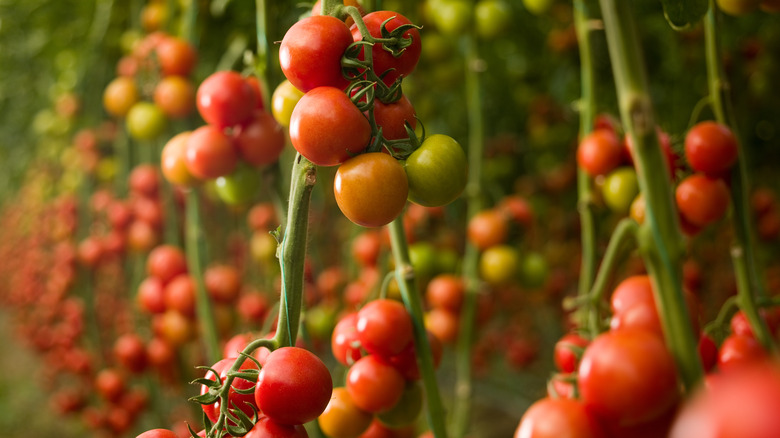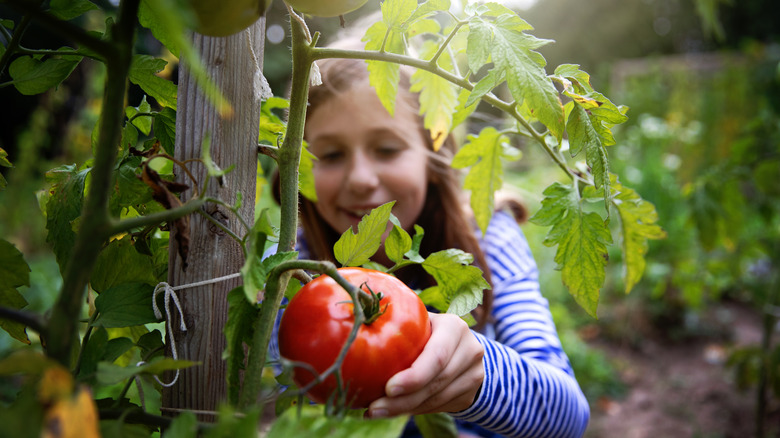Here's What You Can Use For Better Quality Tomatoes And A Bigger Harvest
If you're looking to improve your tomato output throughout the season, you should consider incorporating potassium nitrate into your fertilization routine. Potassium nitrate (KNO3) plays an important role in promoting healthy and abundant tomato harvests due to its impact on plant growth and development. As a key source of essential nutrients, potassium and nitrogen, it contributes to various physiological processes in tomato plants.
Potassium, a macronutrient, aids in water uptake and retention, enhancing the plant's resistance to drought and stress. It improves enzyme activation and nutrient transportation, fostering overall growth and fruit development. Additionally, potassium strengthens cell walls, reducing susceptibility to diseases and pests. Nitrogen, also a vital macronutrient, supports the synthesis of chlorophyll, pivotal for photosynthesis. This process fuels energy production and carbohydrate formation, essential for tomato growth and fruit formation.
Furthermore, the combination of potassium and nitrogen in potassium nitrate supports optimal nutrient absorption and utilization. This bolsters the plant's immune system, allowing it to withstand environmental challenges and diseases, ultimately leading to more robust and disease-resistant plants.
How and when to apply potassium nitrate
If you're looking for healthy and abundant tomato plants that will produce fruits for your kitchen all season long, timing is key for potassium nitrate. As your tomato plants begin their journey in the soil, hold off on the potassium nitrate. Wait until your plants have a few sets of true leaves, usually around four to six weeks after transplanting. This is when they're ready to fully embrace the potassium nitrate. To make a plant-friendly solution, dissolve your potassium nitrate in water -– about 1 to 2 tablespoons in a gallon will do the trick. Stir it well before applying and feel free to scale up accordingly if you have a large collection of tomato plants.
Pour the solution around the base of each tomato plant, aiming to keep the leaves dry to avoid inviting fungal infections. The potassium nitrate mixture will seep into the soil, feeding the roots first. Be cautious, though. Too much of a good thing can lead to overfeeding, so stick to this routine every two to three weeks during the growing season. Hold off on the potassium nitrate if rain is in the forecast soon. You'll want these nutrients to settle into the soil, not be swept away by a sudden downpour. With some careful timing, mixing, and a touch of care, you'll have tomato plants that are the prize of the garden.
Added benefits of potassium nitrate
Potassium nitrate is the supreme tomato fertilizer, with a range of benefits that will make your tomatoes the envy of the neighborhood. First off, let's talk about frost resistance. When temperatures drop, tomato plants can suffer, but potassium nitrate comes to the rescue. It helps strengthen the cell walls of the plants, making them more resilient to frost damage. Moreover, potassium nitrate also improves water use efficiency. It helps the plants take up and retain water, which is especially handy during dry spells. This means your tomatoes won't be left thirsty and droopy, but instead will stay hydrated and healthy even if you spend a weekend away from your garden.
Potassium nitrate works its magic by enhancing nutrient transportation and activating enzymes. This leads to bigger and plumper fruits that will make your mouth water. And not only will they be bigger, but they'll also be more nutritious. The fertilizer supports the synthesis of chlorophyll, which is crucial for photosynthesis. This process fuels energy production and carbohydrate formation, resulting in tomatoes that are packed with flavor and nutrients. Additionally, potassium nitrate improves the visual appearance of your tomatoes. So, say goodbye to unsightly spots and blemishes, and hello to picture-perfect tomatoes.
Finally, potassium nitrate is a sustainable fertilizer. It provides essential nutrients to the plants without harming the environment. It supports optimal nutrient absorption and utilization, making it an eco-friendly choice for your tomato garden.


